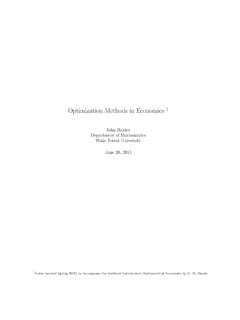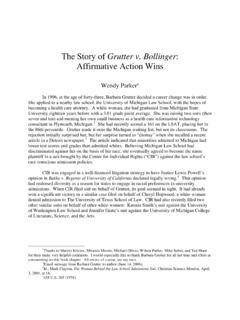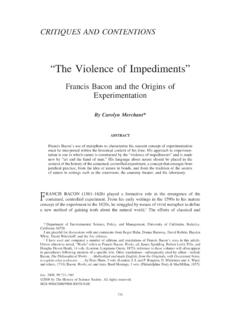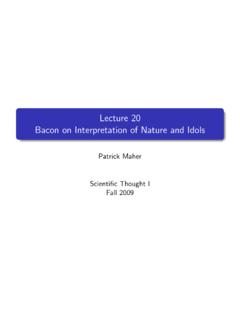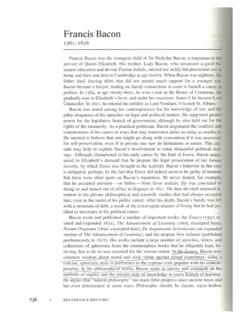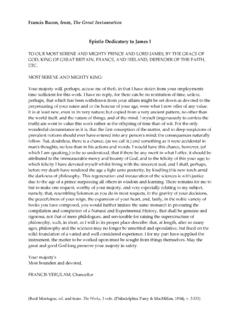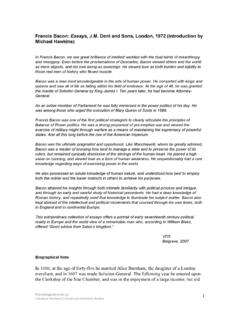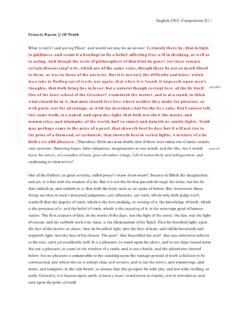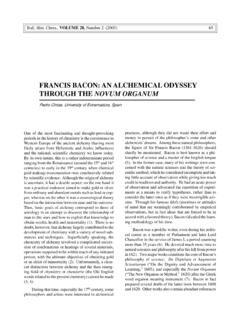Transcription of FRANCIS BACON, Interviews with David Sylvester (1966,1971 …
1 FRANCIS bacon , Interviews with David Sylvester (1966,1971-73) interview , 1966 David Sylvester : It's interesting that the photographic image you've workedfrom most of all isn't a scientific or a journalistic one but a very deliberate and famouswork of art- the still of the screaming nanny from bacon : It was a film I saw almost before I started to paint, and it deeplyimpressed me--I mean the whole film as well as the Odessa Steps sequence and thisshot. I did hope at one time to make-it hasn't got any special psychologicalsignificance-I did hope one day to make the best painting of the human cry. I was notable to do it and it's much better in the Eisenstein and there it is. I think probably thebest human cry in painting was made by : You've used the Eisenstein image as a constant basis and you've done thesame with the Velazquez Innocent X, and entirely through photographs andreproductions of it.
2 And you've worked from reproductions of other old masterpaintings. Is there a great deal of difference between working from a photograph of apainting and from a photograph of reality?FB: Well, with a painting it's an easier thing to do, because the problem's alreadybeen The problem that you're setting up, of course, is another problem. I don'tthink that any of these things that I've done from other paintings actually have : I want to ask whether your love of photographs makes you like reproductionsas such. I mean, I've always had a suspicion that you're more stimulated by looking atreproductions of Velizquez or Rembrandt than at the : Well, of course, it's easier to pick them up in your own room than take thejourney to the National Gallery, but I do nevertheless go a great deal to look at them inthe National Gallery, because I want to see the colour, for one thing.
3 But, if I'd gotRembrandts here all round the room, I wouldn't go to the National : Up to now we've been talking about your working from photographs whichwere in existence and which you chose. And among them there have been oldsnapshots which you've used when doing a painting of someone you knew. But inrecent years, when you've planned to do a painting of somebody, I believe you'vetended to have a set of photographs taken : I have. Even in the case of friends who will come and pose. I've hadphotographs taken for portraits because I very much prefer working from thephotographs than from them. It's true to say I couldn't attempt to do a portrait fromphotographs of somebody I didn't know. But, if I both know them and havephotographs of them, I find it easier to work than actually having their presence inthe room.
4 I think that, if I have the presence of the image there, I am not able to driftso freely as I am able to through the photographic image. This may be just my ownneurotic sense but I find it less inhibiting to work from them through memory andtheir photographs than actually having them seated there before : You prefer to be alone?FB: Totally alone. with their : Is that because the memory is more interesting or because the presence isdisturbing? FB: What I want to do is to distort the thing far beyond the appearance, but in thedistortion to bring it back to a recording of the : Are you saying that painting is almost a way of bringing somebody back, thatthe process of painting is almost like the process of recalling?FB: I am saying it. And I think that the methods by which this is done are so artificialthat the model before you, in my case, inhibits the artificiality by which this thing can bebrought : And what if someone you've already painted many times from memory andphotographs sits for you?
5 FB: They inhibit me. They inhibit me because, if I like them, I don't want to practisebefore them the injury that I do to them in my work. I would rather practise the injury inprivate by which I think I can record the fact of them more : in what sense do you conceive it as an injury?FB: Because people believe--simple people at least--that the distortions of them arean injury to them--no matter how much they feel for or how much they like : Don't you think their instinct is probably right?FB: Possibly, possibly. I absolutely understand this. Nut tell me, who today has beenable to record anything that comes across to us as a fact without causing deep injury tothe image?DS: Is it a part of your intention to try and create a tragic art?FB: No. Of course, I think that, if one could find a valid myth today where there wasthe distance between grandeur and its fall of the tragedies of Aeschylus andShakespeare, it would be tremendously helpful.
6 But when you're outside a tradition, asevery artist is today, one can only want to record one's own feelings about certainsituations as closely to one's own nervous system as one possibly can. But in recordingthese things I may be one of those people who want the distances between what usedto be called poverty and riches or between power and the opposite of : There is, of course, one great traditional mythological and tragic subject you'vepainted very often, which is the : Well, there have been so very many great pictures in European art of theCrucifixion that it's a magnificent armature on which you can hang all types of feelingand sensation. You may say it's a curious thing for a nonreligious person to take theCrucifixion, but I don't think that that has anything to do with it. The great Crucifixionsthat one knows of--one doesn't know whether they were painted by men who hadreligious : It seems to be quite widely felt of the paintings of men alone in rooms thatthere's a sense of claustrophobia and unease about them that's rather horrific.
7 Are youaware of that unease?FB: I'm not aware of it. But most of those pictures were done of somebody who wasalways in a state of unease, and whether that has been conveyed through thesepictures I don't know. But I suppose, in attempting to trap this image, that, as this manwas very neurotic and almost hysterical, this may possibly have come across in thepaintings. I've always hoped to put over things as directly and rawly as I possibly can,and perhaps, if a thing comes across directly, people feel that that is horrific. Because,if you say something very directly to somebody, they're sometimes offended, althoughit is a fact. Because people tend to be offended by facts, or what used to be : On the other hand, it's not altogether stupid to attribute an obsession withhorror to an artist who has done so many paintings of the human : You could say that a scream is a horrific image; in fact, I wanted to paint thescream more than the horror.
8 I think, if I had really thought about what causessomebody to scream, it would have made the scream that I tried to paint moresuccessful. Because I should in a sense have been more conscious of the horror thatproduced the scream. In fact they were too I think that they come out of adesire for ordering and for returning fact onto the nervous system in a more violentway. Why, after the great artists, do people ever try to do anything again? Onlybecause, from generation to generation, through what the great artists have done, theinstincts change. And, as the instincts change, so there comes a renewal of the feelingof how can I remake this thing once again more clearly, more exactly, more see, I believe that art is recording. I think it's reporting. And I think that in abstractart, as there's no report, there's nothing other than the aesthetic of the painter and hisfew sensations.
9 There's never any tension in : You don't think it can convey feelings?FB: I think it can convey very watered-down lyrical feelings, because I think anyshapes can. But I don't think it can really convey feeling in the grand think it's possible that the onlooker can into an abstract painting. But thenanybody can enter more into what is called an undisciplined emotion, because, after all,who loves a disastrous love affair or illness more than the spectator? He can enter intothese things and feel he is participating and doing something about it. But that ofcourse has nothing to do with what art is about. What you're talking about now is theentry of the spectator into the performance, and I think in abstract art perhaps they canenter more, because what they are offered is something weaker which they haven't gotto : If abstract paintings are no more than pattern-making, how do you explain thefact that there are people like myself who have the same sort of visceral response tothem at times as they have to figurative works?
10 FB: : You really think that?FB: I think that only time tells about painting. No artist knows in his own lifetimewhether what he does will be the slightest good, because I think it takes at leastseventy- five to a hundred years before the thing begins to sort itself out from thetheories that have been formed about it. And I think that most people enter a paintingby the theory that has been formed about it and not by what it is. Fashion suggests thatyou should be moved by certain things and should not by others. This is the reason thateven successful artists--and especially successful artists, you may say--have no ideawhatever whether their work's any good or not, and will never : Not long ago you bought a picture ..FB: By : .. by Michaux, which was more or less abstract. I know you got tired of it in the endand sold it or gave it away, but what made you buy it?
